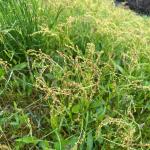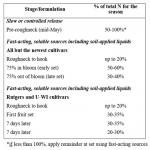Cranberry weevil and green spanworm are the only game in town! These are the 2 pests to be watching for. Many bogs have low or no weevil numbers, a few have the usual 2-4, but a few have fabulously high counts (25-75). A very few growers have already shot their Fanfare to manage these insects. The cool weather has kept most from sweeping and managing! Remember green spanworm is feeding now and will be wrapping up its caterpillar stage in just a week or two.
By far, the most common thing in the sweep net continues to be the tiny collembola. It’s really important to know that they are NOT a cranberry pest. They eat detritus in the bog (trash). These tiny springtails come in many colors (yellow, green, gray and black) and can distract us from the real pests. It is important to know that they are abundant, come in many colors and sizes (small and really small), but the general shape is always the same. They are little round blobs that jump when you poke at them.
If you are looking for tiny black bug (that will appear as little yellow nymphs right now) or tiny blunt-nosed leafhoppers (also little yellow nymphs right now), you need to differentiate these from the collembola. Finding a black bug or a leafhopper is like a needle in a haystack and 99% of what you see will be collembola. Both are very small and yellow.
A dark adult leafhopper is being picked up in very low numbers at a few sites. It has been ID’ed as Constricted Leafhopper and is NOT a pest. Similar in size and color to the adult blunt nosed leafhoppers that we may see in July. Blunt nosed leafhoppers are small yellow nymphs right now.
We have not seen or heard any reports of cutworms, fireworm or sparganothis.
Keep your eyes peeled for scale spots while you are sweeping and pull a few vines from dead areas if you suspect them. You can bring your suspect vines to station for microscope inspection! Timing for scale management is in mid-June when crawlers are being released.
Remember: The Cranberry Station is hosting an Insect Clinic on May 22 (and again on May 29) from 8-10 AM to learn more about and how to ID black bug, blunt nosed leafhopper and scale. An introductory discussion will be followed by a hands-on lab ID if you bring your samples from the bog. The in-person session offers 2 credits and it's FREE to participate. To sign up please contact Marty Sylvia martys@umass.edu or 508-265-6921 (or just show up!!).
Disease and Weed Management.
Much of the information from last week’s IPM message is still relevant. For info on upright dieback, fairy ring, grass control, and timing dodder control please see the previous IPM message
https://ag.umass.edu/cranberry/ipm-message-for-cranberry-growers-may-10-2024
Red sorrel, aka sheep sorrel (Rumex acetosella), is flowering now, and is suddenly very visible everywhere! It is a perennial plant that can thrive in acidic and sandy soil. Once established, they can be difficult to hand-weed since they spread underground by rhizome. It not usually very competitive with established cranberry plants, and is generally only found in new plantings or in areas where vines are thin. In the past, it was considered more of a nuisance than a real weed issue. If this is becoming more widespread in healthy, established beds – we may need to spend more time researching this weed! Please let us know if this weed is becoming more problematic for you.
At this time, there might not be many effective herbicide strategies you can use. The historic recommendation for red sorrel is to use Casoron. If you have patches in established beds, consider mapping the area so you can spot treat with Casoron next spring (since it is probably too late on most beds by now, and Casoron works before weeds emerge). There is some evidence from research on other crops that that sulfentrazone (Zeus/Spartan) can control red sorrel (again, too late for this year). Research from lowbush blueberries showed that there is variable red sorrel control with mesotrione (Callisto) – which aligns with cranberry growers’ observations here. Most growers I have talked to have tried it as a post-emergence after they noticed it everywhere and have not gotten good results. It is possible that earlier applications may be more effective – by the time you notice red sorrel (now) it is already well into making flowers/seeds!
Timing Nitrogen Fertilizer.
You should plan nitrogen fertilizer applications based on soil type and soil temperature.
- On sandy soils (<1% organic matter), nitrogen fertilizer may be applied throughout the season.
- On more organic cranberry soils and older beds, applications should be based on soil temperatures.
- For typical cranberry bogs (1-4% organic matter), applications of N should not be necessary early in the spring. From flood removal until soil temperatures exceed 55°F, adequate N should be available through biological processes (mineralization; the process by which microbes convert N to plant-available forms).
- Nitrogen is slowly released from the soil early in the spring when the cranberry plants are dormant. This leads to a 'flush' of ammonium availability when the plants are breaking dormancy.
- As soil temperatures increase from 55°F to 70°F, release of N through mineralization is only moderate. Fertilizer applications should be beneficial. This corresponds to the period from roughneck stage through bloom.
It is best to time N applications by the growth stage of the plants. Cranberries primarily use N during three stages: early season leaf production, fruit set, and bud set. When N is applied pre-bloom, it is rapidly taken into the plant and moved to the new leafy growth. Adding too much N at this stage can lead to excessive growth. Fruit production is a very high demand period that extends from earliest set to about 3 weeks after the final fruit are set. Bud set is occurring during fruit set, so set applications also support this function.








